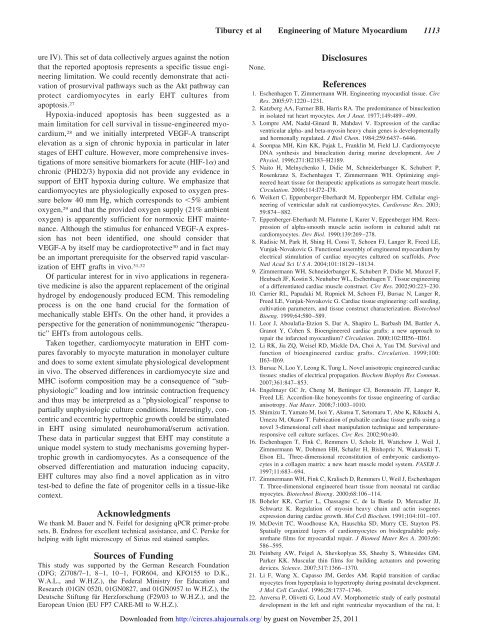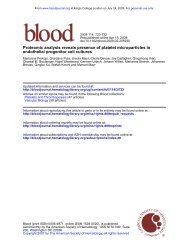Zimmermann Hamdani, Wolfgang A. Linke, Xiaoke Yin, Manuel ...
Zimmermann Hamdani, Wolfgang A. Linke, Xiaoke Yin, Manuel ...
Zimmermann Hamdani, Wolfgang A. Linke, Xiaoke Yin, Manuel ...
You also want an ePaper? Increase the reach of your titles
YUMPU automatically turns print PDFs into web optimized ePapers that Google loves.
Tiburcy et al Engineering of Mature Myocardium 1113<br />
ure IV). This set of data collectively argues against the notion<br />
that the reported apoptosis represents a specific tissue engineering<br />
limitation. We could recently demonstrate that activation<br />
of prosurvival pathways such as the Akt pathway can<br />
protect cardiomyocytes in early EHT cultures from<br />
apoptosis. 27<br />
Hypoxia-induced apoptosis has been suggested as a<br />
main limitation for cell survival in tissue-engineered myocardium,<br />
28 and we initially interpreted VEGF-A transcript<br />
elevation as a sign of chronic hypoxia in particular in later<br />
stages of EHT culture. However, more comprehensive investigations<br />
of more sensitive biomarkers for acute (HIF-1) and<br />
chronic (PHD2/3) hypoxia did not provide any evidence in<br />
support of EHT hypoxia during culture. We emphasize that<br />
cardiomyocytes are physiologically exposed to oxygen pressure<br />
below 40 mm Hg, which corresponds to 5% ambient<br />
oxygen, 29 and that the provided oxygen supply (21% ambient<br />
oxygen) is apparently sufficient for normoxic EHT maintenance.<br />
Although the stimulus for enhanced VEGF-A expression<br />
has not been identified, one should consider that<br />
VEGF-A by itself may be cardioprotective 30 and in fact may<br />
be an important prerequisite for the observed rapid vascularization<br />
of EHT grafts in vivo. 31,32<br />
Of particular interest for in vivo applications in regenerative<br />
medicine is also the apparent replacement of the original<br />
hydrogel by endogenously produced ECM. This remodeling<br />
process is on the one hand crucial for the formation of<br />
mechanically stable EHTs. On the other hand, it provides a<br />
perspective for the generation of nonimmunogenic “therapeutic”<br />
EHTs from autologous cells.<br />
Taken together, cardiomyocyte maturation in EHT compares<br />
favorably to myocyte maturation in monolayer culture<br />
and does to some extent simulate physiological development<br />
in vivo. The observed differences in cardiomyocyte size and<br />
MHC isoform composition may be a consequence of “subphysiologic”<br />
loading and low intrinsic contraction frequency<br />
and thus may be interpreted as a “physiological” response to<br />
partially unphysiologic culture conditions. Interestingly, concentric<br />
and eccentric hypertrophic growth could be stimulated<br />
in EHT using simulated neurohumoral/serum activation.<br />
These data in particular suggest that EHT may constitute a<br />
unique model system to study mechanisms governing hypertrophic<br />
growth in cardiomyocytes. As a consequence of the<br />
observed differentiation and maturation inducing capacity,<br />
EHT cultures may also find a novel application as in vitro<br />
test-bed to define the fate of progenitor cells in a tissue-like<br />
context.<br />
Acknowledgments<br />
We thank M. Bauer and N. Feifel for designing qPCR primer-probe<br />
sets, B. Endress for excellent technical assistance, and C. Perske for<br />
helping with light microscopy of Sirius red stained samples.<br />
Sources of Funding<br />
This study was supported by the German Research Foundation<br />
(DFG; Zi708/7–1, 8–1, 10–1, FOR604, and KFO155 to D.K.,<br />
W.A.L., and W.H.Z.), the Federal Ministry for Education and<br />
Research (01GN 0520, 01GN0827, and 01GN0957 to W.H.Z.), the<br />
Deutsche Stiftung für Herzforschung (F29/03 to W.H.Z.), and the<br />
European Union (EU FP7 CARE-MI to W.H.Z.).<br />
None.<br />
Disclosures<br />
References<br />
1. Eschenhagen T, <strong>Zimmermann</strong> WH. Engineering myocardial tissue. Circ<br />
Res. 2005;97:1220–1231.<br />
2. Katzberg AA, Farmer BB, Harris RA. The predominance of binucleation<br />
in isolated rat heart myocytes. Am J Anat. 1977;149:489–499.<br />
3. Lompre AM, Nadal-Ginard B, Mahdavi V. Expression of the cardiac<br />
ventricular alpha- and beta-myosin heavy chain genes is developmentally<br />
and hormonally regulated. J Biol Chem. 1984;259:6437–6446.<br />
4. Soonpaa MH, Kim KK, Pajak L, Franklin M, Field LJ. Cardiomyocyte<br />
DNA synthesis and binucleation during murine development. Am J<br />
Physiol. 1996;271:H2183–H2189.<br />
5. Naito H, Melnychenko I, Didie M, Schneiderbanger K, Schubert P,<br />
Rosenkranz S, Eschenhagen T, <strong>Zimmermann</strong> WH. Optimizing engineered<br />
heart tissue for therapeutic applications as surrogate heart muscle.<br />
Circulation. 2006;114:I72–I78.<br />
6. Weikert C, Eppenberger-Eberhardt M, Eppenberger HM. Cellular engineering<br />
of ventricular adult rat cardiomyocytes. Cardiovasc Res. 2003;<br />
59:874–882.<br />
7. Eppenberger-Eberhardt M, Flamme I, Kurer V, Eppenberger HM. Reexpression<br />
of alpha-smooth muscle actin isoform in cultured adult rat<br />
cardiomyocytes. Dev Biol. 1990;139:269–278.<br />
8. Radisic M, Park H, Shing H, Consi T, Schoen FJ, Langer R, Freed LE,<br />
Vunjak-Novakovic G. Functional assembly of engineered myocardium by<br />
electrical stimulation of cardiac myocytes cultured on scaffolds. Proc<br />
Natl Acad Sci U S A. 2004;101:18129–18134.<br />
9. <strong>Zimmermann</strong> WH, Schneiderbanger K, Schubert P, Didie M, Munzel F,<br />
Heubach JF, Kostin S, Neuhuber WL, Eschenhagen T. Tissue engineering<br />
of a differentiated cardiac muscle construct. Circ Res. 2002;90:223–230.<br />
10. Carrier RL, Papadaki M, Rupnick M, Schoen FJ, Bursac N, Langer R,<br />
Freed LE, Vunjak-Novakovic G. Cardiac tissue engineering: cell seeding,<br />
cultivation parameters, and tissue construct characterization. Biotechnol<br />
Bioeng. 1999;64:580–589.<br />
11. Leor J, Aboulafia-Etzion S, Dar A, Shapiro L, Barbash IM, Battler A,<br />
Granot Y, Cohen S. Bioengineered cardiac grafts: a new approach to<br />
repair the infarcted myocardium? Circulation. 2000;102:III56–III61.<br />
12. Li RK, Jia ZQ, Weisel RD, Mickle DA, Choi A, Yau TM. Survival and<br />
function of bioengineered cardiac grafts. Circulation. 1999;100:<br />
II63–II69.<br />
13. Bursac N, Loo Y, Leong K, Tung L. Novel anisotropic engineered cardiac<br />
tissues: studies of electrical propagation. Biochem Biophys Res Commun.<br />
2007;361:847–853.<br />
14. Engelmayr GC Jr, Cheng M, Bettinger CJ, Borenstein JT, Langer R,<br />
Freed LE. Accordion-like honeycombs for tissue engineering of cardiac<br />
anisotropy. Nat Mater. 2008;7:1003–1010.<br />
15. Shimizu T, Yamato M, Isoi Y, Akutsu T, Setomaru T, Abe K, Kikuchi A,<br />
Umezu M, Okano T. Fabrication of pulsatile cardiac tissue grafts using a<br />
novel 3-dimensional cell sheet manipulation technique and temperatureresponsive<br />
cell culture surfaces. Circ Res. 2002;90:e40.<br />
16. Eschenhagen T, Fink C, Remmers U, Scholz H, Wattchow J, Weil J,<br />
<strong>Zimmermann</strong> W, Dohmen HH, Schafer H, Bishopric N, Wakatsuki T,<br />
Elson EL. Three-dimensional reconstitution of embryonic cardiomyocytes<br />
in a collagen matrix: a new heart muscle model system. FASEB J.<br />
1997;11:683–694.<br />
17. <strong>Zimmermann</strong> WH, Fink C, Kralisch D, Remmers U, Weil J, Eschenhagen<br />
T. Three-dimensional engineered heart tissue from neonatal rat cardiac<br />
myocytes. Biotechnol Bioeng. 2000;68:106–114.<br />
18. Boheler KR, Carrier L, Chassagne C, de la Bastie D, Mercadier JJ,<br />
Schwartz K. Regulation of myosin heavy chain and actin isogenes<br />
expression during cardiac growth. Mol Cell Biochem. 1991;104:101–107.<br />
19. McDevitt TC, Woodhouse KA, Hauschka SD, Murry CE, Stayton PS.<br />
Spatially organized layers of cardiomyocytes on biodegradable polyurethane<br />
films for myocardial repair. J Biomed Mater Res A. 2003;66:<br />
586–595.<br />
20. Feinberg AW, Feigel A, Shevkoplyas SS, Sheehy S, Whitesides GM,<br />
Parker KK. Muscular thin films for building actuators and powering<br />
devices. Science. 2007;317:1366–1370.<br />
21. Li F, Wang X, Capasso JM, Gerdes AM. Rapid transition of cardiac<br />
myocytes from hyperplasia to hypertrophy during postnatal development.<br />
J Mol Cell Cardiol. 1996;28:1737–1746.<br />
22. Anversa P, Olivetti G, Loud AV. Morphometric study of early postnatal<br />
development in the left and right ventricular myocardium of the rat, I:<br />
Downloaded from http://circres.ahajournals.org/ by guest on November 25, 2011




